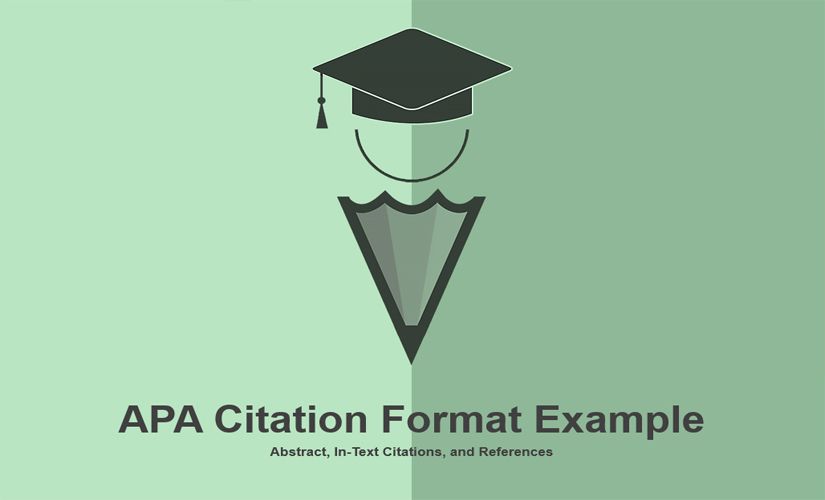Reliable Sources
- 6 July 2019
- 601 words


Although many writers use the American Psychological Association for scientific works, they must follow specific rules. Basically, they use this format because of guidelines that correspond to scientific writing. Also, scholars need the APA citation format example to be familiar with the main principles of the writing style. In this case, a deep understanding of the fundamental guidelines is mandatory. As a result, an in-depth discussion on the basic APA guidelines focuses on in-text citation and reference list formatting rules.
Firstly, people place the “Abstract” section immediately after a title page in the APA paper. Basically, the content of an abstract provides a concise and exhaustive summary of the APA style paper. For a research paper, an abstract highlights the primary concepts, methodological approach, findings, and implications. Similarly, the abstract in the APA citation format example mentions the main points in a general essay. For instance, the length of an abstract is approximately 150 words. However, the word count may vary depending on the instructor’s directives. Particularly, the title “Abstract” is centered horizontally at the top of the page. Also, it appears as a single continuous block of text with no indentation at the beginning of the paragraph. As a result, keywords are provided at the end of the abstract.
Keywords: APA citation format example, APA styling

Then, writers must use the parenthetical in-text citations for the APA citation format example. For instance, they employ the author-date in-text citation format in developing citations. In this case, the APA citation requires the authors’ surnames and the date to be placed in parentheses at the end of the statement but before the punctuation mark. Besides, if the author’s name is mentioned in the sentence, the publication date is placed immediately after the name. In particular, direct quotes should be accompanied by page numbers, which are included in the parenthetical citation. However, if there are no page numbers, alternative locators are provided, for example, paragraph numbers and headings. Also, the APA guidelines encourage authors to provide page numbers or other equivalent locators for paraphrased or summarised material. Therefore, an in-text citation contains the author’s name, publication date, and a page number. Illustrations of various manifestations of in-text citations are:
Name mentioned in a statement: According to Jones (2019), the APA citation format example . . . to avoid plagiarism (p. 234).
Name absent in statement: The APA citation format example . . . to avoid plagiarism (Jones, 2019, p. 234).
Paragraph numbers: Using thresholds, an exclusion criterion . . . to facilitate sampling (Holt, 2019, para. 10).
Headings and no paragraph numbers: Using thresholds, an exclusion criterion . . . to facilitate sampling (Holt, 2019, Method section, para. 10).
No headings or paragraph numbers: Using thresholds, an exclusion criterion . . . to facilitate sampling (Holt, 2019).
Finally, the authors place a complete list of sources at the end of the essay by considering the APA citation format example. For instance, the reference list is labeled “References” and begins on a separate page after the whole work. Also, this title is centered with no additional formatting. Then, each citation entry conforms to the hanging indentation style on the APA reference page. In this case, the first line of a reference list entry is aligned with the left margin. However, the subsequent lines are indented by half an inch. Besides, people put all the references in the chronological order. Hence, the general formats and examples of the APA format reference page for common sources are:
General format: Names of the Authors. (Publication Year). Article’s title. Title of the Journal, volume (issue number), page numbers. DOI/URL
Example: Jones, M., & Saunders, K. (2019). APA citation format example. Journal of Psychological Writing, 10(9), pp. 24-36. https://doi.org/15.99088/psycho2456
General format: Names of the Authors. (Publication Year). The complete title of the book: Complete subtitle. Location, Abbreviation of Location: Publisher’s Name.
Example: Coles, H., & Livingstone, F. (2019). Handbook for beginners: Scientific writing and documentation. New York, NY: Johnstone & Sons.
General format: Names of the Authors. (Date of Electronic Publication). Webpage’s title [Description of the format when necessary]. Retrieval Statement
Example: Paterson, J., & Scofield, K. (2019). APA citation format example. Retrieved from https://writingcentre/blog/formatting_discussion
In conclusion, the fundamental referencing guidelines for the APA citation format example have been discussed in detail. Firstly, people must not forget about the abstract section in their papers. Then, they need to use appropriate in-text citations to avoid plagiarism cases. Also, if authors make mistakes in citing or formatting, the final paper cannot be used for scientific purposes. Hence, writers need to mention all used sources at the end of the paper in the “References” section. However, researchers and students are encouraged to consult the rules of the APA format for more details. Besides, the illustrations used in the discussion are based on random bibliographic information.